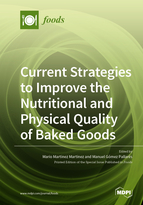Current Strategies to Improve the Nutritional and Physical Quality of Baked Goods
A special issue of Foods (ISSN 2304-8158). This special issue belongs to the section "Grain".
Deadline for manuscript submissions: closed (30 June 2019) | Viewed by 88335
Special Issue Editors
Interests: extrusion; polymer science; carbohydrate chemistry; starch; plant cell walls; phenolics; food functionality; food packaging
Special Issues, Collections and Topics in MDPI journals
Interests: gluten-free; sugar free; fat reduction; flour quality; fiber enrichment
Special Issues, Collections and Topics in MDPI journals
Special Issue Information
Dear Colleagues,
The lifestyle of humans is rapidly changing, and, correspondingly, their needs and the current and future food market mega-trends. It is worth mentioning: 1) the preference for natural, simple and flexible diets that drive further expansion of plant-focused formulations, 2) the focus on food sustainability (food waste reduction), 3) and the interest in healthy eating as the basis for good health. The hectic routine and rapid urbanization in developed and developing regions, respectively, have shifted consumer’s preferences towards bread and baked foods, which, interestingly, are often high in sugars and are categorized as having a high glycemic index. Therefore, it is of major importance to address the technological challenges of manufacturing baked goods with high physical and sensory quality that result in positive metabolic responses. This Special Issue seeks to provide a fundamental understanding and novel strategies to improve the nutritional properties of baked goods, including a decrease in starch bioaccesibility, sugar reduction, increase in fiber and/or protein content, mineral fortification and the improvement of phytochemical bioactivity, among others. This Special Issue will also cover studies on the physical and sensory improvements of baked goods that may provide a mechanistic understanding to minimize the loss of quality after the incorporation of nutritional-improving ingredients, such as edible by-products, proteins or fibers. Last, but not least, studies focused on the reduction of additives (clean label) or fat and on the use of sourdough to improve the sensory properties of baked goods will also be welcome.
Dr. Mario Martinez MartinezProf. Manuel Gomez
Guest Editors
Manuscript Submission Information
Manuscripts should be submitted online at www.mdpi.com by registering and logging in to this website. Once you are registered, click here to go to the submission form. Manuscripts can be submitted until the deadline. All submissions that pass pre-check are peer-reviewed. Accepted papers will be published continuously in the journal (as soon as accepted) and will be listed together on the special issue website. Research articles, review articles as well as short communications are invited. For planned papers, a title and short abstract (about 100 words) can be sent to the Editorial Office for announcement on this website.
Submitted manuscripts should not have been published previously, nor be under consideration for publication elsewhere (except conference proceedings papers). All manuscripts are thoroughly refereed through a single-blind peer-review process. A guide for authors and other relevant information for submission of manuscripts is available on the Instructions for Authors page. Foods is an international peer-reviewed open access semimonthly journal published by MDPI.
Please visit the Instructions for Authors page before submitting a manuscript. The Article Processing Charge (APC) for publication in this open access journal is 2900 CHF (Swiss Francs). Submitted papers should be well formatted and use good English. Authors may use MDPI's English editing service prior to publication or during author revisions.
Keywords
- Cereal and pulse flours
- Starch digestion and glycemic response in baked goods
- Dietary fiber in baked goods
- Phytochemicals, micronutrients and proteins in baked goods
- Food by-products and waste reduction
- Rheological, textural and sensory improvement of baked goods
- Sugar free, fat reduction and gluten-free baked goods
- Whole grain baked goods
- Enzymes in baked goods








